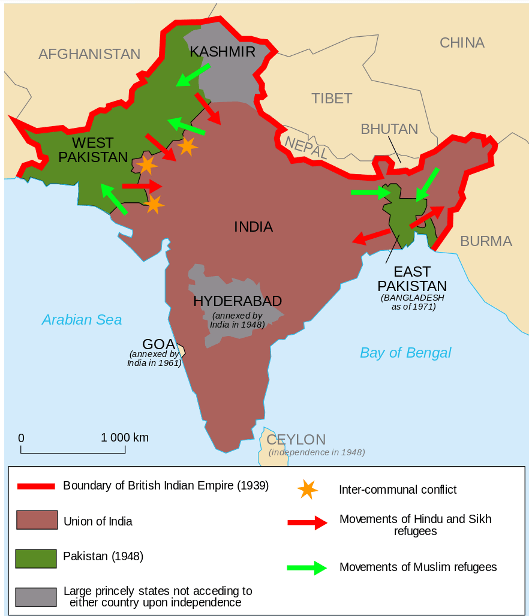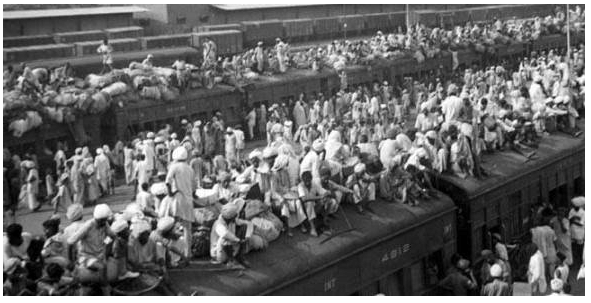UPSC Exam > UPSC Notes > Post Independence History for UPSC Mains > India After Independence
India After Independence | Post Independence History for UPSC Mains PDF Download
Partition and Its Aftermath
- Freedom came with Partition which resulted in large scale communal violence & riots
- In initial few years of independence India faced daunting challenges concerning national unity & territorial integrity
Kind of challenges
- To shape a nation uniting all the states with diversified culture, languages & religions into one nation
- To establish democracy & to develop democratic practices in accordance with the constitution
- to evolve effective polices for economic development and eradication of poverty
- Most of irrigated land gone in partition – Food security to feed those hungry mouths
- To provide shelter & food for refugees from Pakistan
Partition: Displacement and Rehabilitation
On 14–15 August 1947, two nation states came into existence – India & Pakistan; due to “two nation theory” advanced by Muslim League. After 3rd June plan of Mountbatten a British jurist Radcliff was invited to fix the problem and to form two boundary commissions one for Bengal and one for Punjab. On 17th August, 1947 he announced his award.

Limitation of this award
- Justice Radcliff had no prior knowledge about India.
- He had no specialized knowledge needed for the task also.
- He had no advisors and experts.
- 6 week deadline that Radcliff had was also a limitation of this award.
Question for India After IndependenceTry yourself: What was the main reason for the large scale communal violence and riots following Partition?View Solution
Consequence of Partition
- Most abrupt, violent and haphazard, tragic transfer of people in human history
- Brutal killings, atrocities, rapes, on both sides of the border
- Cities like Lahore, Amritsar, Calcutta got divided into “Communal Zones”
- Women were killed by their own family members to preserve the ‘family honor’
- Partition forced about 80 lakhs people to migrate across the new borders
- 5 to 10 lakh people were killed in Partition related violence
The broad strategy for national consolidation after 1947 involved
- Territorial integration
- Mobilization of political and institutional resources
- Economic development
- Adoption of polices to maintain law & order & to promote social justice
Indian Government Measures
Department of rehabilitation was created to Rehabilitate nearly 6 million refugees from Pakistan
- Hindus and Sikhs who were lucky enough to escape arrived India with little more than the clothes on their skin
- Various refugee camps were set up for ex. Kurukshetra Camp and Kolwada camp (Bombay)
- Refugees had to be found permanent homes & productive work – required land for permanent settlement
- Greatest mass migration’ in history also resulted in biggest land resettlement operation in the world

- A massive migration had also taken place the other way, into Pakistan from India. Thus, first place to resettle the refugees was on land vacated by Muslims in the eastern part of the Punjab, which resulted in shortfall of approx. 8 million hectares of land in Punjab.
- This shortfall was made more acute by the fact that the areas in west of the province had richer soils, & were more abundantly irrigated.
- Each family of refugee farmers was given 4 hectares, regardless of its holding in Pakistan.
- Loans were advanced to buy seed & equipment. While cultivation commenced on these temporary plots, applications were invited for permanent allotments.
Question for India After IndependenceTry yourself: What was one of the consequences of the Partition?View Solution
- Every false claim was punished, sometimes by a reduction in the land allotted, or in extreme cases by a brief spell of imprisonment; then also officials estimated an overall inflation of about 25 per cent.
- To collect, collate, verify & act upon the claims a Rehabilitation Secretariat was set up in Jullundur headed by Sardar Tarlok Singh of Indian Civil Service.
- By 1951, the problem of the rehabilitation of Refuges from West Pakistan had been fully tackled.
The document India After Independence | Post Independence History for UPSC Mains is a part of the UPSC Course Post Independence History for UPSC Mains.
All you need of UPSC at this link: UPSC
|
25 videos|44 docs|21 tests
|
FAQs on India After Independence - Post Independence History for UPSC Mains
| 1. What were the major challenges faced by India after independence? |  |
Ans. After gaining independence, India faced various challenges such as poverty, illiteracy, communal tensions, and the task of unifying a diverse nation. The country also had to deal with the partition and the subsequent migration of people, along with the rehabilitation of refugees.
| 2. How did India achieve economic development after independence? |  |
Ans. India adopted a mixed economy model after independence, focusing on industrialization and promoting self-reliance. The government implemented various economic policies, including the Five-Year Plans, to boost agriculture, industry, and infrastructure. The country also emphasized education and skill development to create a skilled workforce.
| 3. What were the key social reforms undertaken in India after independence? |  |
Ans. After independence, India undertook several social reforms to address various social issues prevalent in society. These reforms included measures to eradicate untouchability, promote gender equality, provide education and healthcare facilities to all citizens, and uplift marginalized communities through reservation policies.
| 4. How did India handle the challenges of linguistic and regional diversity after independence? |  |
Ans. India adopted a federal structure that recognized linguistic and regional diversity. The country implemented the three-language formula, which encouraged the learning of three languages - English, Hindi, and the regional language of each state. Additionally, the formation of states based on linguistic lines helped in ensuring regional representation and administration.
| 5. What role did Mahatma Gandhi play in India's struggle for independence? |  |
Ans. Mahatma Gandhi played a pivotal role in India's struggle for independence. He advocated for non-violent civil disobedience and led various movements such as the Salt March and the Quit India Movement. His principles of truth, non-violence, and peace inspired millions of Indians and played a significant role in India's freedom struggle.
Related Searches

















